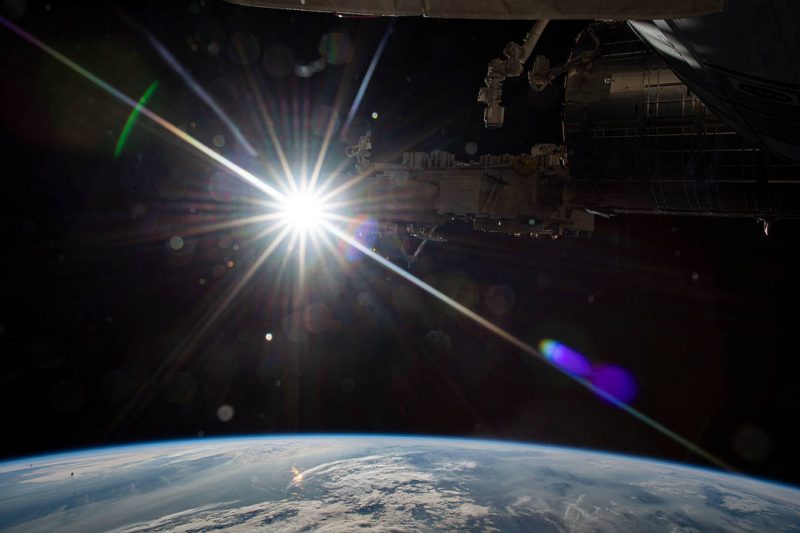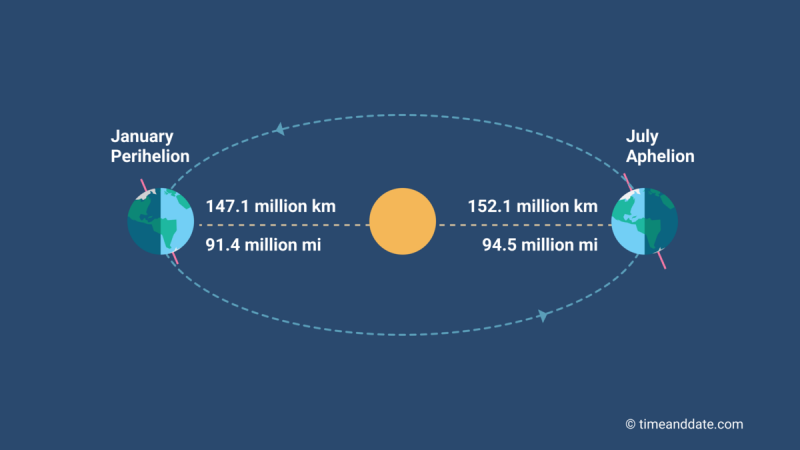
December solstice, January perihelion
Earth comes closest to the sun on January 3-4, 2022. This event is called Earth’s perihelion. Meanwhile, the December solstice was December 21, 2021. The December solstice and January perihelion come close together in time. Are they related? No. It’s just a coincidence that they fall within about a two-week period each year.
The December solstice marked the sun’s southernmost path across our sky. At this solstice, Earth’s Southern Hemisphere tilted most toward the sun. And so it’s summer now in that hemisphere. Meanwhile, the northern half of the globe tilted most away from the sun at the December solstice. We typically say that winter begins at this solstice on our half of the globe.
Perihelion isn’t about Earth’s tilt. It’s about how near or far we are from the sun in orbit. The date of Earth’s perihelion drifts as the centuries pass. These two astronomical events are about two weeks apart for us now. But they were closer a few centuries ago. In fact, in the year 1246 A.D., they happened on the same day.
Date of perihelion drifts
But, like all things in nature, the shape of Earth’s orbit isn’t static. Writing at TimeandDate.com, Aparna Kher explained:
Due to variations in the eccentricity of the Earth’s orbit, the dates when the Earth reaches its perihelion or aphelion are not fixed. Since 1246 A.D., the perihelion and aphelion dates have drifted by a day every 58 years. In the short-term, the dates can vary up to two days from one year to another.
So, as the centuries continue to pass, the December solstice and January perihelion will drift even farther apart. Kher continued:
On the average, one revolution of the Earth relative to perihelion is about 25 minutes longer than one revolution relative to the December solstice. Perihelion advances one full calendar date about every 58 years.
Mathematicians and astronomers estimate that in 6430, over 4000 years from now, the perihelion will coincide with the March equinox.

Bottom line: Earth’s December solstice and January perihelion are not related.
Earth closest to the sun on January 2-3, 2019
Everything you need to know: December solstice
Why does the New Year begin on January 1?
The post Are the December solstice and January perihelion related? first appeared on EarthSky.
from EarthSky https://ift.tt/3sMJfgS

December solstice, January perihelion
Earth comes closest to the sun on January 3-4, 2022. This event is called Earth’s perihelion. Meanwhile, the December solstice was December 21, 2021. The December solstice and January perihelion come close together in time. Are they related? No. It’s just a coincidence that they fall within about a two-week period each year.
The December solstice marked the sun’s southernmost path across our sky. At this solstice, Earth’s Southern Hemisphere tilted most toward the sun. And so it’s summer now in that hemisphere. Meanwhile, the northern half of the globe tilted most away from the sun at the December solstice. We typically say that winter begins at this solstice on our half of the globe.
Perihelion isn’t about Earth’s tilt. It’s about how near or far we are from the sun in orbit. The date of Earth’s perihelion drifts as the centuries pass. These two astronomical events are about two weeks apart for us now. But they were closer a few centuries ago. In fact, in the year 1246 A.D., they happened on the same day.
Date of perihelion drifts
But, like all things in nature, the shape of Earth’s orbit isn’t static. Writing at TimeandDate.com, Aparna Kher explained:
Due to variations in the eccentricity of the Earth’s orbit, the dates when the Earth reaches its perihelion or aphelion are not fixed. Since 1246 A.D., the perihelion and aphelion dates have drifted by a day every 58 years. In the short-term, the dates can vary up to two days from one year to another.
So, as the centuries continue to pass, the December solstice and January perihelion will drift even farther apart. Kher continued:
On the average, one revolution of the Earth relative to perihelion is about 25 minutes longer than one revolution relative to the December solstice. Perihelion advances one full calendar date about every 58 years.
Mathematicians and astronomers estimate that in 6430, over 4000 years from now, the perihelion will coincide with the March equinox.

Bottom line: Earth’s December solstice and January perihelion are not related.
Earth closest to the sun on January 2-3, 2019
Everything you need to know: December solstice
Why does the New Year begin on January 1?
The post Are the December solstice and January perihelion related? first appeared on EarthSky.
from EarthSky https://ift.tt/3sMJfgS

Aucun commentaire:
Enregistrer un commentaire